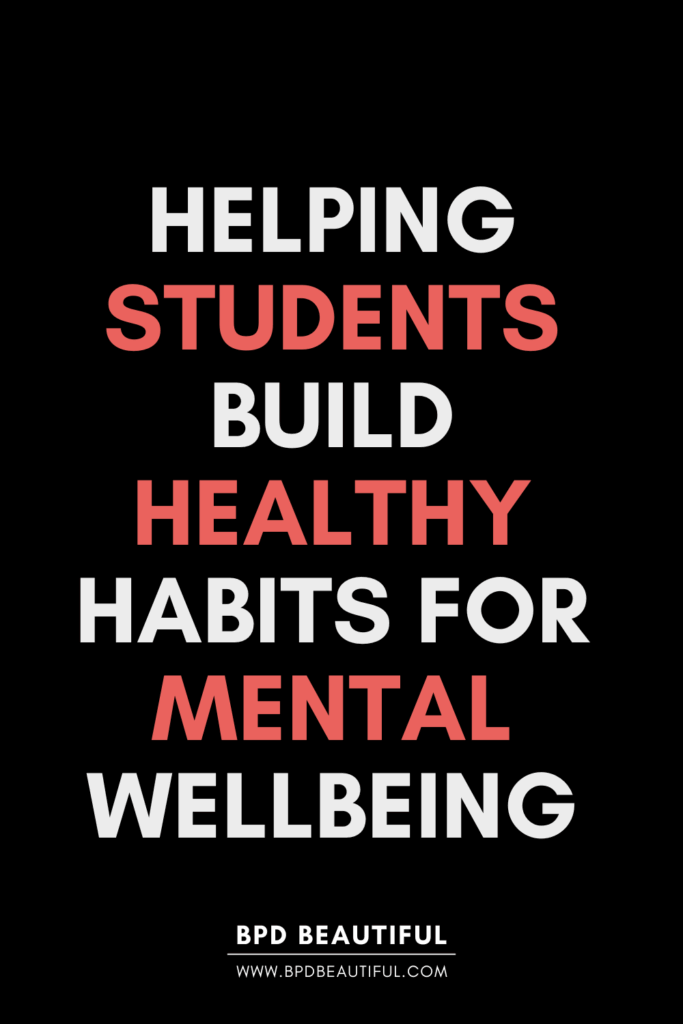In today’s fast-paced world, student mental wellbeing has become a significant concern for educators and parents alike. As individuals grapple with various stressors, instilling healthy habits in children and young adults has never been more crucial. Establishing these habits early can pave the way for a balanced life, equipping students to handle academic pressures and personal challenges with resilience.
Looking to better understand BPD? Sadie’s Favorite: A Novel + Original Soundtrack explores BPD, trauma bonds, FP relationships and healing after emotional abuse. Click to learn more.
The Importance of Student Mental Wellbeing
Mental health is not just an aspect of education but its foundation. It plays a critical role in:
- Improved Concentration and Performance: Students who maintain good mental health can stay focused and absorb information more effectively, which leads to higher academic achievement. A stable mental state helps prevent burnout, allowing them to participate actively in their learning experiences.
- Emotional Stability and Resilience: A sound mental state fosters emotional stability, enabling students to confidently manage stress and navigate difficult situations. Being resilient allows them to approach challenges with a positive attitude and recover more quickly from setbacks
- Increased Overall Happiness: When mental wellbeing is prioritized, students experience higher levels of satisfaction and joy both in and out of the classroom. This overall sense of happiness enables them to build healthier relationships and pursue their interests with enthusiasm and optimism.
Challenges Faced
Recognizing the common challenges that students face in developing mental wellbeing is the first step toward offering effective support:
- Anxiety and Depression: Anxiety and depression are becoming increasingly prevalent among young people, often manifesting as a result of overwhelming academic demands and social pressures. These conditions can severely impact a student’s ability to concentrate, affect their self-esteem, and lead to prolonged periods of distress.
- Impact of Social Media: The pervasive influence of social media has introduced new challenges, such as cyberbullying and increased feelings of inadequacy stemming from comparing oneself to carefully curated online personas. This constant exposure can erode self-esteem and lead to social anxiety, exacerbating existing mental health issues.
- Family and Academic Pressures: Students can feel immense pressure to excel academically and meet family expectations, which can place a significant emotional burden on them. This stress can lead to burnout, decreased motivation, and a pervasive sense of failure if their efforts do not match expectations.



Sadie’s Favorite: A Novel + Original Soundtrack is a character-driven story about BPD recovery, trauma bonds and breaking away from abuse.
Practical Strategies for Schools
By adopting these practical strategies, schools can significantly enhance student mental wellbeing and overall development. Schools play a crucial role in shaping students’ lifestyles, making them an ideal environment for fostering healthy habits. Some strategies include:
1.Promote Regular Physical Activity:
- Implement daily exercise routines.
- Encourage participation in sports and extracurricular activities.
- Integrate short physical breaks during classes to enhance focus and energy.
2. Nutrition Education:
- Provide access to healthy food choices within school cafeterias.
- Educate students on the importance of balanced nutrition through workshops and classes.
- Host healthy cooking demonstrations or events involving students and parents.
3. Mindfulness and Relaxation:
- Create quiet spaces for relaxation and mindfulness practices.
- Introduce yoga or meditation sessions as part of the curriculum or after-school programs.
- Offer training for teachers on facilitating mindfulness activities in the classroom.

As a BetterHelp affiliate, we receive compensation from BetterHelp if you purchase products or services through the links provided.
Role of Educators and Parents
The collaboration between educators and parents is crucial for fostering an environment that supports student mental wellbeing:
Educators:
Blend physical activities into academic lessons to keep students engaged and attentive.
Host informative sessions on mental health, emphasizing its role in overall well-being and personal growth.
Parents:
Reinforce consistent routines at home that underscore the importance of rest, balanced nutrition, and physical activity.
Set aside family time for activities promoting physical health and emotional bonding.
Addressing Challenges
Despite the best intentions, implementing changes can be met with challenges. Limited resources, curriculum constraints, or resistance from stakeholders may hinder progress. However, forging school-community partnerships can bring additional resources and support. Professional development opportunities for educators to learn about the latest strategies in health and wellness can also facilitate smoother transitions and greater impact.
Final Thoughts
Schools and parents can significantly uplift their mental health landscape by integrating healthy habits into students’ lives. It’s a collective responsibility that promises immense rewards—a generation equipped not only with academic knowledge but with the resilience and strength to navigate the complexities of life. Let us commit to prioritizing and safeguarding the mental health of our young learners, ensuring they have the foundation to thrive in every aspect of their lives.

Looking for BPD Characters?
Sadie’s Favorite explores the dynamics of Borderline + Narcissist Relationships and BPD Recovery. Read first 6 chapters.
BPD Resources
BPD in Fiction: Sadie’s Favorite is a Novel + Original Soundtrack, that touches on BPD, favorite person (FP) relationships, healing after abuse, parenting and more. Written by Sarah Rose, creator of BPD Beautiful. Soundtrack performed by Them vs. Her.
Get 20% off your first month of BetterHelp. Get matched with a licensed therapist within 48 hours. Subscriptions as low as $65/week, billed every 4 weeks. Cancel anytime.
Manage your BPD symptoms with a printable workbook.
See our recommended list of books about BPD.
Start a Discussion
Have you tried incorporating these tips to help you in managing the intense emotions that come from having BPD &/or anxiety? Tell us about it in the comments.
Pin this Post
Liked this post? Please help support BPD Beautiful and spread borderline personality disorder awareness by pinning it to Pinterest.




